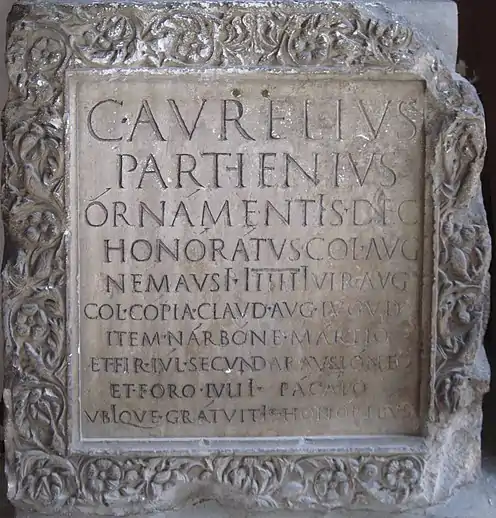| ◌᷄ | |
|---|---|
Apex | |
| not in Unicode, approximation: U+1DC4 ◌᷄ COMBINING MACRON-ACUTE |
In written Latin, the apex (plural "apices") is a mark with roughly the shape of an acute accent ◌́ which was sometimes placed over vowels to indicate that they are long.
The shape and length of the apex can vary, sometimes within a single inscription. While virtually all apices consist of a line sloping up to the right, the line can be more or less curved, and varies in length from less than half the height of a letter to more than the height of a letter. Sometimes, it is adorned at the top with a distinct hook, protruding to the left. Rather than being centered over the vowel it modifies, the apex is often considerably displaced to the right.[1]
Essentially the same diacritic, conventionally called in English the acute accent, is used today for the same purpose of denoting long vowels in a number of languages with Latin orthography, such as Irish (called in it the síneadh fada [ˈʃiːnʲə ˈfˠad̪ˠə] or simply fada "long"), Hungarian (hosszú ékezet [ˈhosːuː ˈeːkɛzɛt], from the words for "long" and "wedge"), Czech (called in it čárka [ˈtʃaːrka], "small line") and Slovak (dĺžeň [ˈdl̩ːʐeɲ], from the word for "long"), as well as for the historically long vowels of Icelandic. In the 17th century, with a specialized shape distinct from that of the acute accent, a curved diacritic by the name of "apex" was adopted to mark final nasalization in the early Vietnamese alphabet, which already had an acute accent diacritic that was used to mark one of the tones.
Details

Although hardly known by most modern Latinists, the use of the sign was actually quite widespread during classical and postclassical times. The reason why it so often passes unnoticed lies probably in its smallish size and usually thinner nature in comparison with the lines that compose the letter on which it stands. Yet the more careful observer will soon start to notice apices in the exhibits of any museum, not only in many of the more formal epigraphic inscriptions, but also in handwritten palaeographic documents. However, otherwise punctilious transcriptions of the material customarily overlook this diacritic.
An apex is not used with the letter ⟨i⟩; rather, the letter is written taller, as in lv᷄ciꟾ·a·fꟾliꟾ (lūciī a fīliī) at left.
.jpg.webp)


uobis · ujdetur · p · c · decerna᷄m[us · ut · etiam]
pro᷄la᷄tis · rebus ijs · ju᷄dicibus · n[ecessitas · judicandi]
impona᷄tur quj · jntra᷄ rerum [· agenda᷄rum · dies]
jncoha᷄ta · judicia · non · per[egerint · nec]
defuturas · ignoro · fraudes · m[onstro᷄sa · agentibus]
multas · aduersus · quas · exc[ogita᷄uimus]...
Other expedients, like a reduplication of the vowels, are attested in archaic epigraphy; but the apex is the standard vowel-length indication that was used in classical times and throughout the most flourishing period of the Roman education system. Its use is recommended by the best grammarians, like Quintilian, who says that writing the apex is necessary when a difference of quantity in a vowel can produce a different meaning in a word, as in malus and ma᷄lus or liber and líber or rosa and rosa᷄.[2]

In modern Latin orthography, long vowels are sometimes marked by a macron, a sign that had always been used, and still is, to mark metrically long syllables (more recently called heavy syllables). To confuse matters further, the acute accent is sometimes used in Latin to mark stressed syllables, as in Spanish, when the macron is not used.
Identification with the sicilicus
The apex is often contrasted with another ancient Latin diacritic, the sicilicus, which is said to have been used above consonants to denote that they should be pronounced double. However, in his article Apex and Sicilicus, Revilo P. Oliver argues that they are one and the same sign, a geminationis nota, which was used over any letter to indicate that the letter should be read twice. The distinction between a sicilicus that was used above consonants and an apex that was applied to vowels is then completely artificial: "There is no example of this mark [the sicilicus] that can be distinguished from an apex by any criterion other than its presence above a letter that is not a long vowel." "No ancient source says explicitly that there were two different signs; ...". The presence of this sign, whatever its name, over a consonant is very scarcely attested.
If Revilo P. Oliver is right, the apex as a sign denoting vowel length would have its origin in the time when long vowels were written double. Then, when long vowels ceased to be regularly written twice, the usage of the sicilicus above vowels evidently remained, even after it fell out of use above consonants, and the apex, as it was now called, was redefined as a sign denoting the phonematic feature of vowel length, rather than as a purely orthographic shorthand.
However, Oliver's view that the two marks were identical has recently been challenged; see sicilicus.
Usage in Middle Vietnamese
In the 17th and 18th centuries, the Vietnamese alphabet incorporated both acute and apex marks. The acute indicates rising tone, while the apex marked final nasalization.[3] In his 1651 Dictionarium Annamiticum Lusitanum et Latinum, Alexandre de Rhodes makes it clear that the apex is a distinct diacritic:[4][5][6]
The third sign, finally, is the apex, which in this language is entirely necessary because of a difference in the ending [i.e. of a word], which the apex makes entirely distinct from the ending that m or n makes, with a meaning entirely diverse in words in which it is employed. However, this sign, namely the apex, only affects o᷄ and u᷄, at the end of a word, as ao᷄ "bee", ou᷄ "grandfather" or "lord". It is pronounced, however, such that neither the lips touch together nor the tongue touches the palate.
The apex appears atop ⟨o⟩, ⟨u⟩, and less commonly ⟨ơ⟩. As with other accent marks, a tone mark can appear atop the apex.[8]
According to canon law historian Roland Jacques, the apex indicated a final labial-velar nasal /ŋ͡m/, an allophone of /ŋ/ that is peculiar to the Hanoi dialect to the present day. The apex apparently fell out of use during the mid-18th century, being unified with ⟨-ng⟩ (representing /ŋ/), in a major simplification of the orthography, though the Vietnamese Jesuit Philipphê Bỉnh (Philiphê do Rosario) continued to use the old orthography into the early 19th century.[9] In Pierre Pigneau de Behaine and Jean-Louis Taberd's 1838 Dictionarium Anamitico-Latinum,[10] the words ao᷄ and ou᷄ became ong and ông, respectively.
The Middle Vietnamese apex is known as dấu sóng or dấu lưỡi câu in modern Vietnamese. Though it has no official Unicode representation, one possible approximation is U+1DC4 ◌᷄ COMBINING MACRON-ACUTE. The apex is often mistaken for a tilde in modern reproductions of early Vietnamese writing, such as in Phạm Thế Ngũ's Việt Nam văn học sử.[11][12]
Vietnamese examples
Obtained from Dictionarium Annamiticum Lusitanum et Latinum, a trilingual Vietnamese, Portuguese and Latin dictionary by Jesuit Alexandre de Rhodes.
 The entry for dĕóu᷄ shows distinct breves (ĕ), acutes (ó), and apices (u᷄).
The entry for dĕóu᷄ shows distinct breves (ĕ), acutes (ó), and apices (u᷄). The entry for blu᷄́ shows that a vowel with an apex can take on an additional tone mark, in this case an acute.
The entry for blu᷄́ shows that a vowel with an apex can take on an additional tone mark, in this case an acute. The entry for bao giơ᷄ đến illustrates the difference between a horn and an apex.
The entry for bao giơ᷄ đến illustrates the difference between a horn and an apex.
See also
References
- ↑ Apex and Sicilicus, Revilo P. Oliver, The American Journal of Philology, Vol. 87, No. 2. (Apr., 1966), p. 149.
- ↑ Inst. 1,7,2s: adponere apicem ... interim necessarium, cum eadem littera alium atque alium intellectum, prout correpta vel producta est, facit: ut 'malus' arborem significet an hominem non bonum apice distinguitur, 'palus' aliud priore syllaba longa, aliud sequenti significat, et cum eadem littera nominativo casu brevis, ablativo longa est, utrum sequamur plerumque hac nota monendi sumus.
- ↑ Jacques, Roland (2002). Portuguese Pioneers of Vietnamese Linguistics. Bangkok: Orchid Press. p. 91.
The accent mark written by the amanuensis on the first word can be read as the apex (or tilde), an abbreviation sign used in 17th and 18th century Quốc Ngữ to represent the rounded nasal finals: '-aõ' (spelt today '-ong'); '-oũ' (= '-ông'), and '-ũ' (= '-ung'). Thus 'chã' would stand for the word presently spelt 'chẳng.'
Note that de Rhodes called the tilde a "circumflex". - ↑ Nguyễn Khắc Xuyên (1993). Ngữ Pháp Tiếng Việt của Đắc Lộ 1651 [De Rhodes's Vietnamese grammar of 1651] (in Vietnamese). Garden Grove, California: Thời điểm. OCLC 32129692. Archived from the original on November 12, 2011.
- ↑ de Rhodes, Alexandre (1991) [1651]. "Về các dấu và dấu hiệu khác trên nguyên âm". In Hồ Lê; Cao Xuân Hạo; Hồ Tuyết Mai (eds.). Từ điển Annam-Lusitan-Latinh (Thường gọi Từ điển Việt-Bồ-La) (in Vietnamese). Translated by Thanh Lãnh; Hoàng Xuân Việt; Đỗ Quang Chính. Ho Chi Minh City: Social Science Publishing House. p. 11.
- ↑ Nguyễn Thị Bạch Nhạn (1994). Sự biến đổi các hình thức chữ quốc ngữ từ 1620 đến 1877 [Changes in the Vietnamese alphabet's form from 1629 to 1877] (PDF) (PTSKH) (in Vietnamese). Hà Nội: Hanoi National University of Education. Archived from the original (PDF) on 2014-03-09. Retrieved 2014-03-08.
- ↑ de Rhodes, Alexandre (1651). "De Accentibus & aliis signis in vocalibus.". Dictionarium annamiticum lusitanum, et latinum (in Latin). Rome: Sacred Congregation for the Propagation of the Faith. p. 10.
- ↑ de Rhodes, Alexandre (1651). cou᷄̀ la (in Latin). Rome: Sacred Congregation for the Propagation of the Faith. p. 135.
{{cite encyclopedia}}:|work=ignored (help) - ↑ Jacques, Roland (1998). "Le Portugal et la romanisation de la langue vietnamienne. Faut-il réécrire l'histoire ?" [Portugal and the romanization of the Vietnamese language. Should we rewrite history?]. Revue française d'histoire d'outre-mer (in French). Société française d'histoire d'outre-mer. 85 (318): 52. doi:10.3406/outre.1998.3600.
- ↑ Pigneaux, Pierre Joseph (1838). "Litterarum anamiticarum ex ordine disposita series". In Taberd, Jean-Louis (ed.). Dictionarium anamitico-latinum (in Latin). Joshua C. Marshman.
- ↑ Phạm Thế Ngũ (1961). Việt Nam Văn Học Sử: Giản Ước Tân Biên [History of Vietnamese Literature: New Survey] (in Vietnamese). Saigon: Quốc Học Tùng Thư. p. 61 – via Google Books.
- ↑ "Bulletin de l'Institut de recherches archéologiques". Việt-Nam khảo-cổ tập-san: Bulletin de l'Institut de recherches historiques (in Vietnamese). Vietnam Historical Research Institute: 86. 1961 – via Google Books.